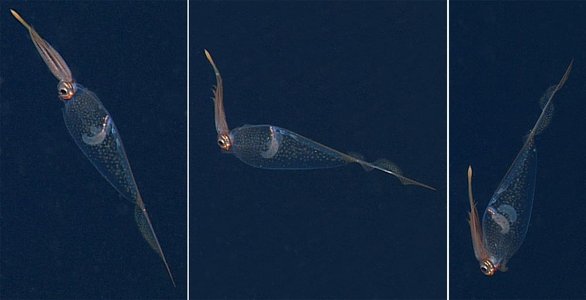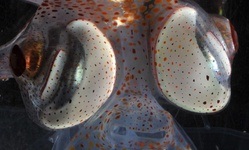Galiteuthis phyllura
Richard E. Young and Katharina M. Mangold (1922-2003)Introduction
This may be the largest species of Galiteuthis if it reaches a length of 2.7 m ML as Nesis (1982) thinks. G. phyllura has been observed repeatedly by underwater vehicles. Hunt (1996) describes a behavior observed by an ROV that may be typical of many cranchiids. When disturbed, this squid hyperinflates the mantle with water and releases ink inside the mantle cavity. It thereby transforms itself from a nearly transparent squid into a very dark one.
Characteristics
- Head
- Beaks: Descriptions can be found here: Lower beak; upper beak.
- Beaks: Descriptions can be found here: Lower beak; upper beak.
- Photophores
- Lateral (near lens) ocular photophore bar-shaped.
- Lateral (near lens) ocular photophore bar-shaped.
- Tubercules at fused locking apparatuses
- At mantle-funnel fusion: 2-4 small, conical tubercules.
- At mantle-nuchal fusion: none.
Comments
Additional details of the description of G. phyllura can be found here.
Nomenclature
Galiteuthis beringiana (Sasaki, 1920) is a junior synonym of this species (Nesis, 1982).
Behavior


Figure. Side views of G. phyllura, insitu, showing the near vertical position of the eyes, digestive gland and arm crown as the body rotates about 90° presumably to reduce the shadow produced by these structrures. Photographs © 2011 MBARI.
Life History



Figure. Left - Growth stages of G. phyllura, ventral views. A - 170 mm GL. B - 79 mm GL. C - 33 mm GL. D - 13 mm GL. Drawings from Young, 1972. Right - In situ photographs of G. Phyllura at 526 m depth. This paralarva is somewhat larger than fig. C. © 2013 MBARI.


Figure. - Side-oblique view of a young G. phyllura about the size of fig. C above. Note the stalked eyes, characteristic of most paralarval Taoniinae, here and in the above two photographs. Note also the characterisitc large, broadly scattered and slightly elongate chromatophores. In the above two photographs these are buried beneath smaller yellowish chromatophores that are not obvious in the dead paralarva. Photographed freshly caught by Danté Fenolio.
Distribution
Geographical distribution
The type locality is Monterey Bay, California (temperate eastern North Pacific). Its distribution extends from off Baja California to the Bering Sea to off northern Japan (Nesis, 1982).
References
Hunt, J. C. 1996. The behavior and ecology of midwater cephalopods from Monterey Bay: Submersible and laboratory observations. Ph. D. Dissertation, Univ. Calif. Los Angeles. 231 pp.
Young, R. E. 1972. The systematics and areal distribution of pelagic cephalopods from the seas off Southern California. Smithson. Contr. Zool., 97: 1-159.
Title Illustrations

| Scientific Name | Galiteuthis phyllura |
|---|---|
| Location | Monterey Bay Canyon, Northeast Pacific at 36.7°N, 122.0°W. |
| Comments | Image courtesy of the Monterey Bay Aquarium Research Institute (MBARI). You must obtain permission from MBARI to use this photo; please contact pressroom@mbari.org for further information |
| Acknowledgements | Susan Von Thun, photo editing, MBARI |
| Specimen Condition | Live Specimen |
| View | Side |
| Copyright | © 2011 MBARI |
About This Page

University of Hawaii, Honolulu, HI, USA
Katharina M. Mangold (1922-2003)

Laboratoire Arago, Banyuls-Sur-Mer, France
Page copyright © 2015 and Katharina M. Mangold (1922-2003)
 Page: Tree of Life
Galiteuthis phyllura .
Authored by
Richard E. Young and Katharina M. Mangold (1922-2003).
The TEXT of this page is licensed under the
Creative Commons Attribution-NonCommercial License - Version 3.0. Note that images and other media
featured on this page are each governed by their own license, and they may or may not be available
for reuse. Click on an image or a media link to access the media data window, which provides the
relevant licensing information. For the general terms and conditions of ToL material reuse and
redistribution, please see the Tree of Life Copyright
Policies.
Page: Tree of Life
Galiteuthis phyllura .
Authored by
Richard E. Young and Katharina M. Mangold (1922-2003).
The TEXT of this page is licensed under the
Creative Commons Attribution-NonCommercial License - Version 3.0. Note that images and other media
featured on this page are each governed by their own license, and they may or may not be available
for reuse. Click on an image or a media link to access the media data window, which provides the
relevant licensing information. For the general terms and conditions of ToL material reuse and
redistribution, please see the Tree of Life Copyright
Policies.
- Content changed 11 October 2015
Citing this page:
Young, Richard E. and Katharina M. Mangold (1922-2003). 2015. Galiteuthis phyllura . Version 11 October 2015 (under construction). http://tolweb.org/Galiteuthis_phyllura/19574/2015.10.11 in The Tree of Life Web Project, http://tolweb.org/













 Go to quick links
Go to quick search
Go to navigation for this section of the ToL site
Go to detailed links for the ToL site
Go to quick links
Go to quick search
Go to navigation for this section of the ToL site
Go to detailed links for the ToL site